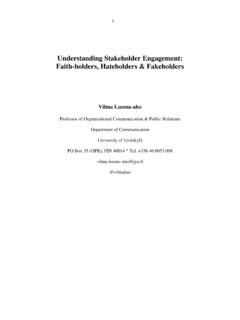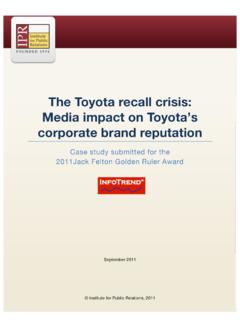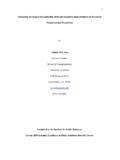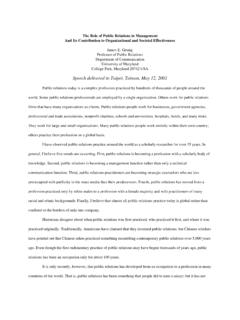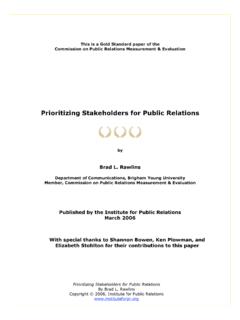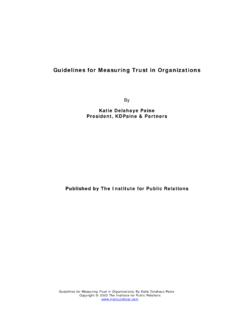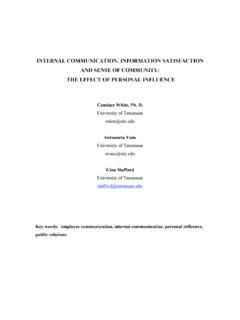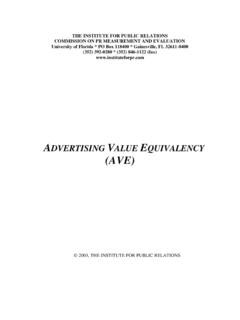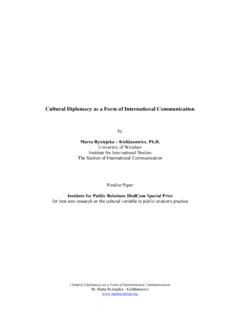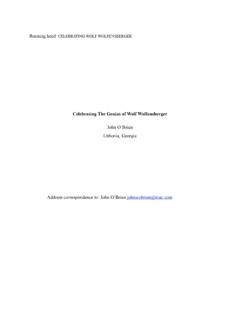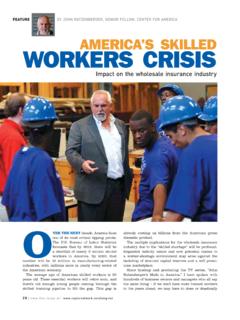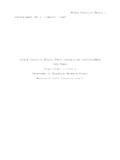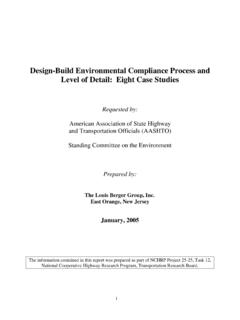Transcription of THE INSTITUTE FOR PUBLIC RELATIONS COMMISSION ON PR ...
1 THE INSTITUTE FOR PUBLIC RELATIONS . COMMISSION ON PR MEASUREMENT AND EVALUATION. University of Florida * PO Box 118400 * Gainesville, FL 32611-8400. (352) 392-0280 * (352) 846-1122 (fax). GUIDELINES FOR MEASURING. THE EFFECTIVENESS OF. PR PROGRAMS AND ACTIVITIES. 1997, 2003, THE INSTITUTE FOR PUBLIC RELATIONS . This booklet was first published in 1997 under the title, Guidelines and Standards for Measuring and Evaluating PR Effectiveness. It was originally written by Dr. Walter K. Lindenmann, based on guidance, input and suggestions from a task force of PR practitioners, counselors, academicians and research suppliers that included the following individuals: Forrest W.
2 Anderson Albert J. Barr Dr. Mary Ann Ferguson Dr. James E. Grunig Thomas Martin Geri Mazur Willard Nielsen Charlotte Otto Katharine D. Paine David Silver Kathleen Ward Mark Weiner and Dr. Donald K. Wright. The booklet was updated and revised in 2002 and given a new title, Guidelines for Measuring the Effectiveness of PR Programs and Activities, . to more accurately reflect its contents. The revised version is primarily the work of Dr. Walter K. Lindenmann, with input and suggestions from Fraser Likely. CONTENTS. Foreword 1. Overview 2.
3 Some Guiding Principles 4. Major PR Measurement and Evaluation Components 5. Getting Specific: Standards For Measuring PR Outputs 9. Getting Specific: Standards For Measuring PR Outtakes 13. Getting Specific: Standards For Measuring PR Outcomes 15. Questions That Need To Be Put To Those Organizations That COMMISSION PR Measurement and Evaluation Studies 18. Questions That Need To Be Put To Those Research Suppliers, Agencies and Consulting Firms That Actually Conduct PR Measurement and Evaluation Studies 20. Definitions of Selected Terms Used In PR Measurement and Evaluation 23.
4 FOREWORD. For years we have been told that we can never expect to get proper credit for what we do in PUBLIC RELATIONS until we can find an effective way to measure our effectiveness. Most other professions have recognized measuring tools -- engineering devices, chemical reactions, case law, charts and figures. But PUBLIC RELATIONS efforts have always been gauged in a variety of ways -- each using a different kind of measuring stick. In an attempt to begin to find a uniform "ruler" we can all use for measurement, a PUBLIC RELATIONS Evaluation Summit was called in October, 1996 in New York City.
5 This gathering of top leaders interested in PUBLIC RELATIONS research was sponsored by the INSTITUTE for PUBLIC RELATIONS , INSIDE PR, and the Ketchum PUBLIC RELATIONS Research and Measurement Department. As a result of that Summit, a booklet was published and distributed in 1997 under the title, Guidelines and Standards for Measuring and Evaluating PR Effectiveness as a first attempt to establish guidelines for how we might begin to agree on uniform ways to measure PUBLIC RELATIONS by using the same measuring sticks. In the light of new developments relating to PR measurement overall, this booklet was revised in 2002 and given a new title, Guidelines for Measuring the Effectiveness of PR Programs and Activities, to more accurately reflect its contents.
6 We view the revised version of this book as a companion to Guidelines for Measuring Relationships in PUBLIC RELATIONS , and Guidelines for Setting Measurable Objectives, both of which were published in 1999. We believe you can use the ideas and suggestions in this booklet as a working document of ways we can continue a dialogue on measuring the effectiveness of PUBLIC RELATIONS . Jack Felton President & CEO. 1. OVERVIEW. What is PUBLIC RELATIONS measurement and evaluation? Basically, it is any and all research designed to determine the relative effectiveness or value of what is done in PUBLIC RELATIONS .
7 In the short-term, PR measurement and evaluation involves assessing the success or failure of specific PR programs, strategies, activities or tactics by measuring the outputs, outtakes and/or outcomes of those programs against a predetermined set of objectives. In the long-term, PR measurement and evaluation involves assessing the success or failure of much broader PR efforts that have as their aim seeking to improve and enhance the relationships that organizations maintain with key constituents More specifically, PR measurement is a way of giving a result a precise dimension, generally by comparison to some standard or baseline and usually is done in a quantifiable or numerical manner.
8 That is, when we measure outputs, outtakes and outcomes, we usually come up with a precise measure -- a number; for example, 1,000 brochures distributed 60,000 hits on a website 50% message recall an 80% increase in awareness levels, etc. PR evaluation determines the value or importance of a PR program or effort, usually through appraisal or comparison with a predetermined set of organization goals and objectives. PR. evaluation is somewhat more subjective in nature, or softer, than PR measurement, involving a greater amount of interpretation and judgment calls.
9 Interest in PUBLIC RELATIONS measurement and evaluation has surged in recent years, as the PUBLIC RELATIONS field has grown in size and sophistication, and as those who practice in the field have found themselves more often than ever being asked to be accountable for what they do. Those who supervise or manage an organization's total communications activities are increasingly asking themselves, their staff members, their agencies and consulting firms, and their research suppliers questions such as these: -- Will those PUBLIC RELATIONS and/or advertising efforts that we initiate actually have an effect -- that is, "move the needle" in the right direction -- and, if so, how can we support and document that from a research perspective?
10 -- Will the communications activities we implement actually change what people know, what they think and feel, and how they actually act? -- What impact -- if any -- will various PUBLIC RELATIONS , marketing communications, and advertising activities have in changing consumer and opinion-leader awareness, understanding, retention, attitude and behavior levels? 2. As questions such as these have increased in number in recent years, many PUBLIC RELATIONS practitioners -- as they seek to justify what they, themselves, do -- have sensed a need to establish guidelines or criteria that the industry can follow, when it comes specifically to PUBLIC RELATIONS measurement and evaluation.
